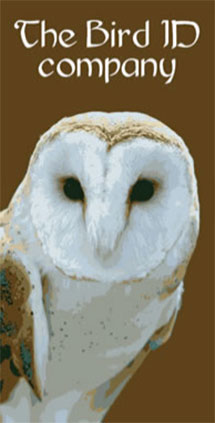Finders in the Field: Citril Finch, Burnham Overy Dunes, Norfolk 10 May 2015
by Marcus Nash - The Bird ID Company
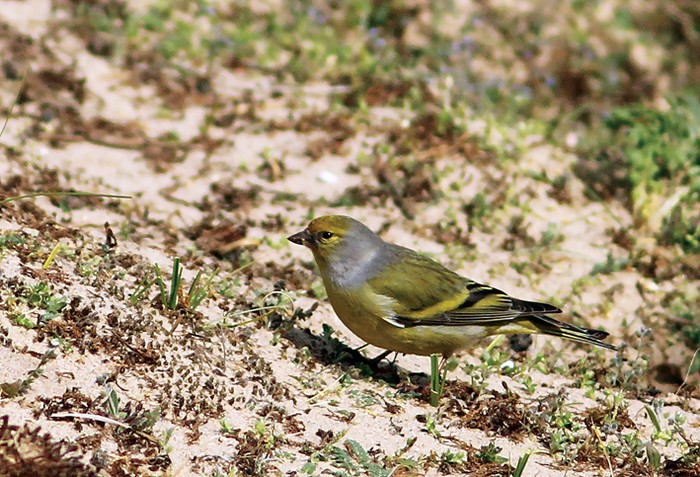
I would normally be leading a birding group on a Sunday, but this was a rare weekend off. However, even when I am not working I cannot resist the temptation to get out birding, especially in May. Saturday was windy, cold and damp and birds were hard to find, but the forecast looked better for Sunday. Checking Twitter on Saturday night, I could see there had been a few common migrants arriving along the Yorkshire coast late in the day, so that was enough of an excuse to get me out early on Sunday morning.
I headed for Holkham Pines and Burnham Overy Dunes. This can often be a good place for migrants and I thought I might find a Redstart or a flycatcher. I arrived a little later than I had hoped, so I hurried along past the pines to get out into the dunes as quickly as possible. Unfortunately, when I got there the first impression was disappointing and there seemed to be very few birds around in the scrub at the end of the pines, certainly no hint of any newly-arrived migrants. In fact, I walked around for a while and barely saw anything.
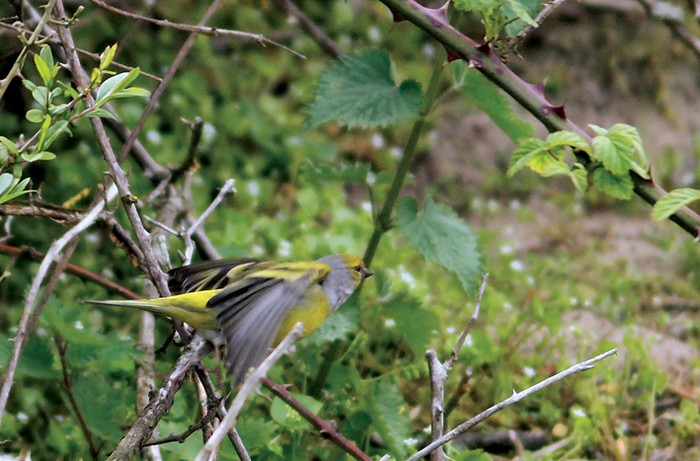
At the top of one of the dunes, I flushed a bird out of a bush. I only saw it briefly as it dropped down over the ridge and, in the complete absence of anything else to look at and more to motivate myself to keep going, I convinced myself I should really make absolutely sure it was just a Robin. As I walked up onto the crest and looked down into the gully I could see the Robin when a second bird flew up from the grass and round below me. All I saw at first was an off-yellowish rump contrasting with a dark tail and rather plain greyish-green back as it flew. For a second or so I was confused – it didn’t seem to fit anything. It was the wrong shape for a Greenfinch, too long-tailed and not heavily-built enough, leaving aside the fact that the rest of it didn’t fit. It wasn’t a Serin either, and Siskin was not even a possibility. What other green-yellow finches are there? Thankfully, it flew up onto the top of the dunes and landed in a low bare bush around 30 metres away from me, perched side on. When I got my bins onto it, I knew immediately what it was. I have seen Citril Finch in the Alps in the past and this was a cracking male. Lovely bright yellowish face, grey shawl, two yellowish-green wing bars. I just didn’t believe it – it couldn’t be a Citril Finch in Norfolk, could it?
I was on my own and after a few seconds watching it in mounting disbelief, I figured I should try and get a photo of it. For some reason, rather than get a distant record shot with my bridge camera, I decided to get it in the scope and digiscope it. Wrong decision! I knelt down and put my scope on the ground, but just at the very moment I was lining it up I heard a cheerful ‘Good Morning’ from in front of me and two walkers came round below the dune where the bird was perched. As I got the scope on the bush, the Citril Finch was gone.
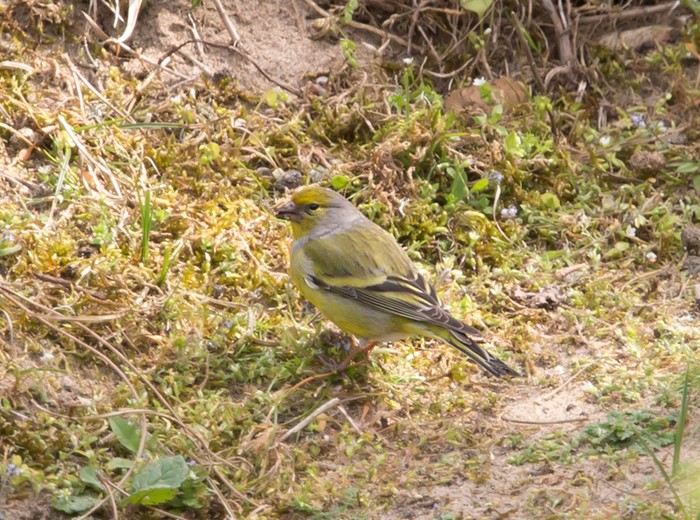
Panic started to set in, but I stopped to think. I knew I could rule out any alternative species, based on what I had seen, but I still needed to eliminate the possibility that it was an escaped cage bird. I didn’t want to get lots of people out into the dunes, only to find that it was sporting a ring. I had to refind it. So I walked carefully round the immediate area, checking the likely gullies and bushes, but there was no sign. Burnham Overy Dunes is a huge area and there was no one else out there that morning, so I tried phoning for help. The Holkham regulars were either not answering or busy. Eventually I managed to get hold of a couple of people who agreed to come out, though I knew it would take them some time to get to me. In the meantime I walked round methodically, in ever increasing circles out through the dunes, though with a growing sense of dread that it had flown. By this stage, it was over an hour since I had seen it.
I had reasoned that it was likely to remain around the edge of the pines, the most like its regular alpine habitat (though Norfolk is not renowned for its mountains!), so had focused my efforts on there. Then, as I made another pass through the area where I had first seen it, it suddenly flew up from the grass again and over the dune in front. Fortunately, at that stage help arrived. We had several more brief views in flight in quick succession and just when we thought we had lost it again, it flew up and landed right in front of one of the others. It was head on, and it was clearly unringed. Then it flew off towards the pines. I phoned the news out and gradually more people started to arrive. However, we had lost the bird again and couldn’t find it where we thought it had landed. It was a nervous couple of hours before it finally flew out again and eventually settled to feed in an area where it could be viewed from the top of the dunes. Great views, all round. Job done!
If you had asked me to write a list of all the birds I thought I might find in the dunes on a May morning, even in my wildest dreams, I don’t think Citril Finch would have been on it. It just goes to show, you never can tell what might be round the next dune!
Marcus Nash
The Bird ID Company
11 May 2015
The Bird ID Company
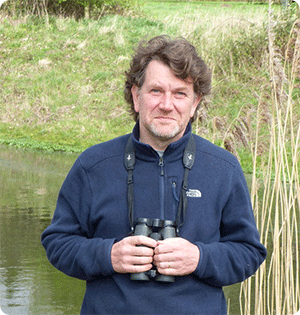
The Bird ID Company has been operating tours for almost 15 years. We specialise in tours to Norfolk and neighbouring Suffolk, which enables us to offer a wide range of dates and different tours across East Anglia. This regional focus also means we can ensure that we have detailed knowledge of the sites we visit and the birds we are looking for, and up-to-date information about the best places to look.
Group sizes are kept as small as possible, generally only up to 6, to make sure all the participants have the best chance to see the birds. Particularly with our focus on getting more out of birdwatching and developing new identification skills, we believe it is important to ensure that each member of the group has the maximum opportunity both to observe the birds closely and ask questions of the leader.
I was born and raised in Norfolk and started birdwatching here at the age of 8, which marked the start of a lifelong passion for birds and wildlife. I studied Zoology at university and wrote my dissertation on Little Egrets in the Camargue, France. After travelling extensively, birdwatching in various countries, I settled in London to live and work for several years. During that period I still took every opportunity to indulge my interest in birds, with regular trips all around the world and visits back to my home county whenever possible.
I made the decision to leave behind my career and move back to Norfolk permanently with my family in 2006, with a view to turning my hobby into a profession. Over the last eight years, I have spent most of my time out in the field, studying birds and their behaviour, investigating different aspects of bird identification, and enjoying other wildlife. This has involved extensive travel around East Anglia, where I have developed a particular interest in how the distribution of different species has changed since I was younger. I also play a very active role in the birding community; amongst other things, I am a serving member of the Norfolk Rarities Committee and I am a regular contributor to the Norfolk Bird Report.
I took over the running of the Bird ID Company in 2014, which is the perfect way to allow me to share my knowledge and enthusiasm with others. I hope to carry on running the tours in the same format and just as successfully as they have been run in the past.
Thanks to Penny Clarke for her photos and video
Write for Rare Bird Alert
Do you have a birding story you would like to share? From foreign birding trips to your local patch, finders accounts and more, we would love to hear from you.
All our articles are free for anyone to view and we include them in our weekly newsletter which goes out to thousands of birders every Wednesday. We also share them on our Twitter and Facebook pages, making sure your article will get read by as many people as possible.
If you would like to write an article please for us please get in touch with your ideas, thank you.
The RBA team


